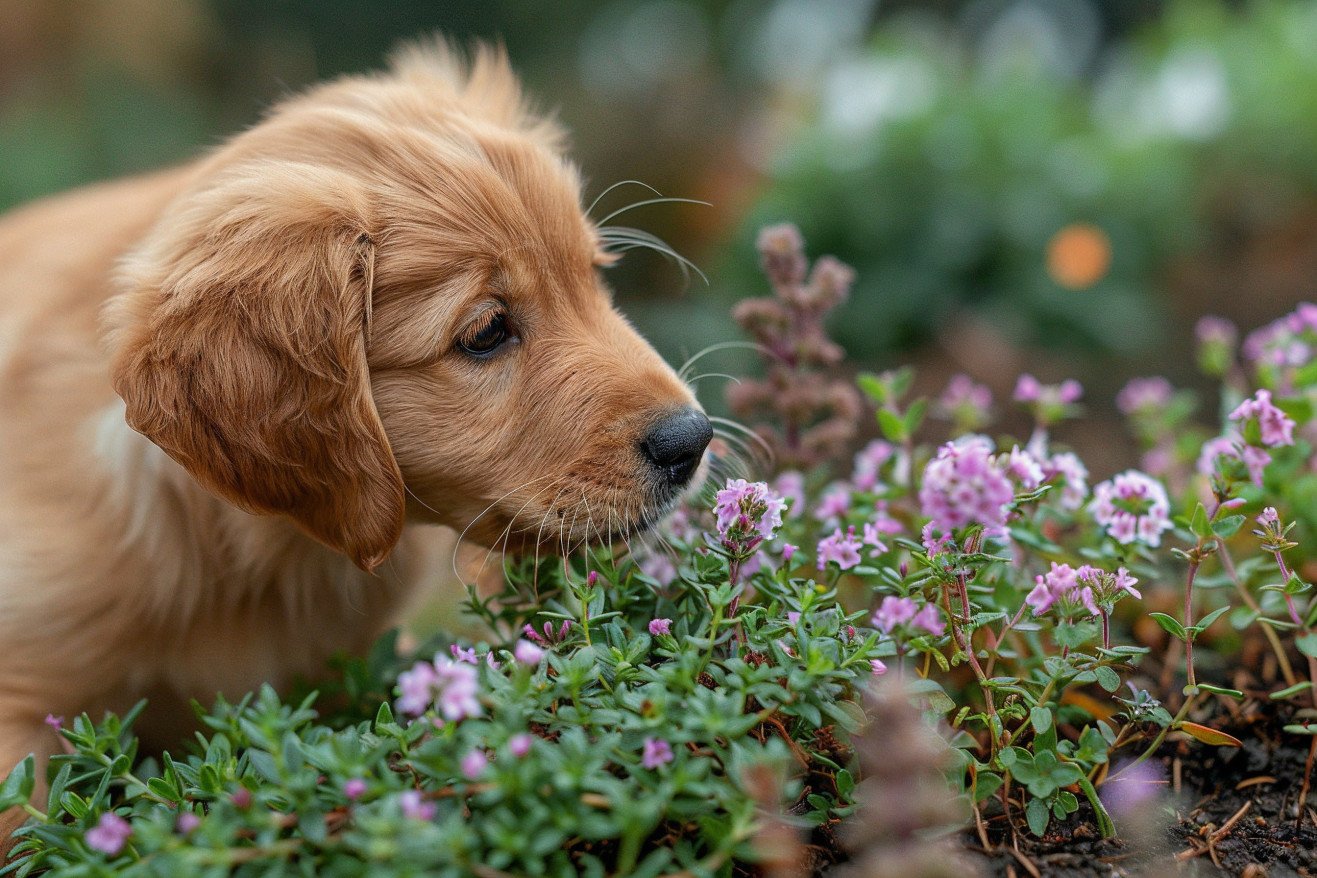Can Dogs Eat Creeping Thyme? Important Information for Dog Owners
26 April 2024 • Updated 24 April 2024

If you're thinking about planting creeping thyme in your garden or using it in your home, but you have a dog, you may be wondering whether creeping thyme is safe for your furry friend. The good news is that creeping thyme is safe for dogs and even offers some health benefits. However, as with anything, there are some things to watch out for, such as the potential for digestive upset if your dog eats too much of it.
To help you better understand this topic, we've researched information from veterinarians, nutritionists, and horticulturalists. This comprehensive approach will help us learn more about the nutritional content of creeping thyme, any potential dangers or downsides, and the best ways to feed it to our dogs. With this knowledge, you can feel more confident in your decision to introduce this herb to your dog's life and diet.
Is creeping thyme safe for dogs?
Creeping Thyme: A Dog-Safe Ground Cover That Can Be Used in a Variety of Ways
Creeping thyme is a popular ground cover option for gardens because of its low-growing, spreading nature and its ability to withstand being walked on. It is also non-toxic, so it is safe for dogs to be around and can be planted in dog-friendly areas, according to the American Society for the Prevention of Cruelty to Animals.
When planting creeping thyme, Milorganite advises that you create barriers and keep dogs in one part of the yard while you work on planting the ground cover in another part of the yard. This will allow the plants to establish themselves without being disturbed. You can then move on to the next section and continue this process until the entire area is covered.
There are also planting and maintenance strategies that can help prevent dogs from damaging creeping thyme with their urine or by digging. The Honest Kitchen recommends using barriers or deterrents, such as decorative fencing, rocks, or pinecones, to keep dogs away from the plants. You can also train your dogs to go to the bathroom in certain areas to help prevent damage, according to DogSpotlight.
Nutritional Benefits and Potential Risks of Creeping Thyme for Dogs
Creeping thyme has been shown to contain thymol and carvacrol, which can help with digestion and act as an antioxidant in dogs, according to the ASPCA. That said, it's also worth noting that consuming large amounts of creeping thyme can lead to potential toxicity in dogs, including gastrointestinal upset, central nervous system depression, and liver or kidney damage, according to MasterClass.
The likelihood of toxicity is dependent on the dog's size, sensitivity, and the amount of thyme they consume. Greg.app explains that while Common Thyme is not toxic to dogs, if it's consumed in large amounts, it can lead to mild gastrointestinal upset. If a dog has consumed a large amount of creeping thyme, it's important to keep a close eye on them and contact a vet if any symptoms of concern occur.
Other Options: Ground Covers That Are Safe for Dogs
Even though creeping thyme is safe for dogs, some people may want to know about other options for ground covers that are safe for dogs and that work well in dog-friendly gardens. Bhg.com lists several ground covers that are safe for dogs, including sedum, clover, ajuga, vinca, and liriope.
These ground covers are all walkable and provide a dense, low-growing cover for dog-friendly gardens. For example, sedum is a succulent that is safe for dogs and can take a lot of foot traffic, according to PlantEnders.com. Meanwhile, clover is a safe, spreading ground cover that can take some foot traffic.
When choosing ground covers, it’s important to consider things like the amount of sun and type of soil in your garden, as well as how well the ground cover can stand up to potential damage from dogs. For example, as the Extension Service points out, some ground covers, like Mondo grass and Corsican mint, may not be hardy enough for colder climates, while others, like Scotch moss and some varieties of creeping thyme, are well-suited to these conditions.
Protecting Creeping Thyme: How to Keep Dogs From Harming Your Plants
While creeping thyme is a tough plant, it can be damaged or even killed by dog urine if it’s exposed to it for long periods of time, according to Dogster. To protect creeping thyme from this potential threat, pet parents can use physical barriers like decorative fencing or rocks or logs to keep dogs away from the plants, according to DogSpotlight.
In addition, pet parents can protect garden beds by mulching them with materials that are less attractive to dogs, such as thorny bushes, junipers, or pinecones, according to Dogster. Finally, pet parents can train their dogs to go to the bathroom in certain areas and dilute the urine in spots where their dogs have gone with water to help protect their creeping thyme plants, according to Dogster.
By using these methods, pet parents can make sure that they can enjoy the advantages of creeping thyme while also making sure their dogs don’t accidentally cause damage to the plants.
Conclusion: How to Integrate Creeping Thyme Into a Dog-Safe Landscape
Creeping thyme can be a great addition to a dog-friendly garden or landscape, as long as you take the necessary precautions. According to the ASPCA, creeping thyme is not toxic to dogs, so it is generally safe to have around them. That said, you should be careful about how much creeping thyme your dog consumes, as it can lead to digestive upset if they eat too much, according to MasterClass.
By following the best practices for planting, maintaining, and protecting creeping thyme that are described by Milorganite and The Honest Kitchen, you can make sure that you and your pets can enjoy the benefits of this useful plant without any worries. If you’d rather use a different plant, Bhg.com lists a number of other non-toxic ground cover plants that are good for dog-friendly gardens.


